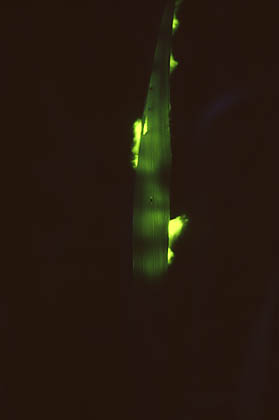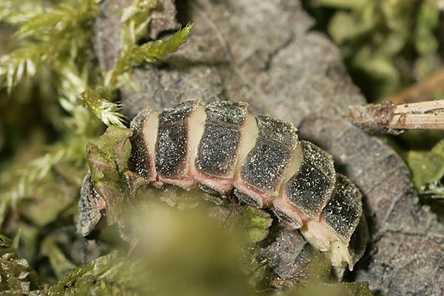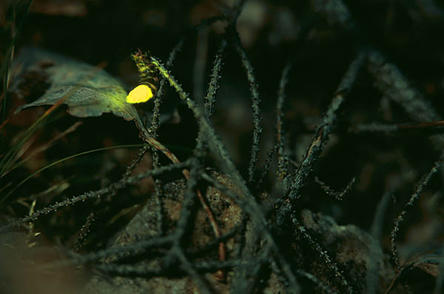Text: Piret Pappel
Photos: Urmas Tartes and Arne Ader
Translation: Liis
Glow-worm, photo: Arne Ader
In the nights before Midsummer you may see little patches of greenish light at forest verges and on roadsides. They are glow-worms, popularly called jaaniussid in Estonian – midsummer or St John’s worms. Their correct Estonian name, jaanimardikas, says however that the glow-worm is not really a “worm“ (as for instance an earthworm) but a beetle. The popular name glow-worm comes from the wingless females that remind us of little worms. Their greenish glow is a signal to attract the flying males.
Glow-worm light, photo: Urmas Tartes
Relatives
The firefly family (
Lampyridae) is known for their ability to produce a fosforescent glow. The Latin name means “torch bearer“.
There are some 2000 firefly species, and their names generally refer to the luminescent properties of the insects. Besides family
Lampyrus (torch bearer) we find the families
Lucidota (lux – light),
Pyractonema (same stem as in pyroman),
Photinus (from the word photo) in the same group. The size of these glowing insects ranges from four millimetres to a couple of centimetres.
Many beliefs are tied to the glow-worms. It is said that great good luck will come to the finder of such a glowing little creature, its killer however will be punished by fire disaster. Weather has been foretold from glow-worms: locally the little creatures have been believed to predict both rain and sunshine.

A glow-worm's half-hour journey on a blade of grass, photo Arne Ader
Hellfires
How does the “torch“ of the glow-worms work?
The luminescence is caused by luciferin, during the decomposition of this protein by the enzyme luciferase. The name of the protein refers to an unearthly being – the fallen angel Lucifer. The shining green dots in the June nights might be called the lights of the Prince of the Underworld.
The decomposition reaction takes place in specialised cells – photocytes - that are clustered under the cuticle at the rear end of the abdomen. Oxygen is necessary for the decomposition of luciferine. Accordingly the intensity of the glow depends primarily on the inflow of oxygen through the trachea, and its concentration in the photocytes. The beetles are able to regulate the intensity of their glow. Precisely how they do it is not known yet. In addition to being able to control the concentration of oxygen, the glow-worms can also regulate the glow by way of the nervous system.
Light bulb
The light of the glow-worms is cold, it does not yield much heat. The decomposition of luciferine has an exceptional efficiency rate: as much as 98 % of the energy used goes to produce light and only 2% to heat. As comparison the ratios are almost reversed in a common light bulb. The light from the glow-worms does not contain any infra-red or ultraviolet parts of the spectrum, the wavelength of the light is mainly between 480 and 720 nm. Some tropical species glow so strongly that it is possible to read a book in the dark by the light from a few of these insects in a jar. American schoolbooks tell the story of the military surgeon William Gorgas, who used the light from glow-worms at surgical operations in the field on Cuba. Among many tropical glow-worm species the females as well as males glow. Probably the glow-worms use the glow to detract enemies. But frogs for instance are not frightened by the weak glow. They happily eat glow-worms although a large amount of this glowing dish can make even the eater glow.
Offspring
The light of the glow-worms is brightest between sunset and midnight. The beetles spend the day in trees or low plants. Many species prefer moist habitats. The larger part of their 3-year life the glow-worms spend as larvae that feed on caterpillars. The brief adult life, lasting only a few weeks, forces many sexually mature beetles to a total fast. If food is taken, pollen and nectar is preferred. The female glow-worms lay their eggs in the soil and die within a few days after this. One female lays about 50 eggs. Larvae hatch in about four weeks. The summer is spent in eating and growing. In the autumn the glow-worm larvae bore into the soil to survive the winter there.
-
Class: Insects Insecta
-
Order: Beetles Coleoptera
-
Family Lampyridae
-
Glow-worm Lampyris noctiluca
-
Length: males ~ 1cm, females ~1,5 up to 2cm, larvae up to 2,5 cm
-
Life length: up to 3 years
-
Eggs: about 50
-
The capacity to glow is present in the glow-worm larvae and even eggs.
-
Favourite food of larvae is snails that are killed with poison fangs.
-
Another glow worm, the European lesser glow worm (Phosphaenus hemipterus), has been found in Estonia; they too glow but markedly weaker than the common glow-worms.











